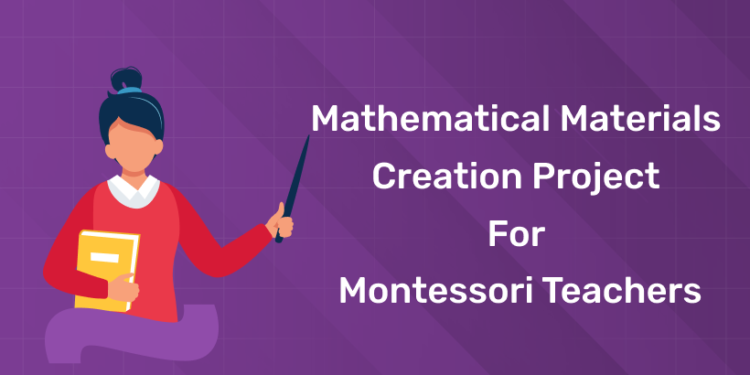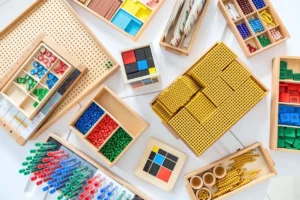Table of Contents
Looking for guidance on how to a create mathematical materials project for Montessori teachers? This blog talks about types of mathematical materials and their uses, tools required to create them, and guidance on how to document and present your project.
Introduction
Education is consistent in one particular aspect, and that is being dynamic! This is because the curriculum and the teaching style are always adaptive. Montessori Teacher Training courses strive to ensure that a child-centred approach is curated with guiding the children through self-directed activities in a carefully prepared environment. A Montessori classroom is bound to contain a lot of engaging tools and activities that act as stimuli for the child development, including cognitive, physical, social, and emotional.
Therefore, creating a material that enhances the learning of a child requires careful planning and execution. Especially when it comes to mathematics, the value that these materials possess increases drastically. Mathematics is the basis and can be seen in extremely complex scenarios as well as in our day-to-day activities. Creating a strong foundation of mathematics in children will definitely be beneficial for them in the long run.
Kickstart your Montessori teaching career with a free demo here!!
Types of Mathematical Materials Creation and Their Uses in Montessori Classrooms
1: What is the primary focus of the first plane of development in the Montessori method?
The Montessori Mathematics Curriculum is deeply rooted in the philosophy that children learn best through tactile experiences. Children are encouraged to learn at their own pace with tools of their choice that they deem comfortable. The materials that are used are closely associated with the same aim as well. Following are the types of Montessori mathematical materials and their uses in Montessori classrooms:
-
Number
The number materials strive to develop an understanding and introduce concepts such as quantity, symbols, place value, linear counting, and the decimal system. Some of the top number materials include:
| Material | Description | Purpose |
| Stamp Game | Stamps that denote units, tens, hundreds, and thousands | Practical experience of the decimal system |
| Number Rods | Rods with sections coloured alternately red and blue, representing 1-10 | Grasp linear counting and length in accordance to number |
| Numerical Cards | Cards containing numbers and corresponding value | Identify and recognise numbers and values |
| Spindle box | Box with compartments and spindles | Associate numbers with quantity and zero as the absence of quantity |
| Golden Bead Material | Beads representing units, tens, hundreds, and thousands | Understanding the decimal system and place value |
-
Operations
The operation materials aim to make the children understand operations like addition, subtraction, multiplication, division, and fractions. Some of the top operation materials are as follows:
| Material | Description | Purpose |
| Addition Strip board | Board with multi-coloured strips representing numbers | To visualize the addition process |
| Subtraction Strip Board | Similar to the addition board but for subtraction | To visualize the subtraction process |
| Multiplication Table | A grid for understanding multiplication | Hands-on experience with multiplication |
| Division Table | A grid for understanding division | Hands-on experience with division |
| Fraction Circles | Circles divided into different fractions | Introduction to the concept of fractions |
-
Measurement
These materials help children in understanding concepts such as length, weight, capacity, temperature, volume, time, and money. The best measurement materials are as follows:
| Material | Description | Purpose |
| Measuring Sticks | Sticks of varying lengths | Understand and compare lengths |
| Knobbed Cylinders | Blocks with cylindrical insets of varying dimensions | Understand and compare sizes and dimensions |
| Metal Insets | Representations of coins | Understand the value of money |
| Weighing Scale | Tool for measuring weight | Grasp the concept of weight and compare different objects |
| Clock without movable hands | Clock for teaching time | Learn to tell the time |
-
Geometry
The geometry materials help children develop a visual understanding of shapes, spatial relationships, and geometric properties. Some of the best materials are as follows:
| Material | Description | Purpose |
| Geometric Solids | 3D shapes like scones, spheres, and cubes | To understand three-dimensional shapes |
| Geometry sticks | Sticks of varying lengths and angles | Explore geometric relationships and properties |
| Geometry Cards | Cards with geometric shapes and properties | Deepen understanding of geometric shapes and their characteristics |
| Plane Geometry Set | Set of shapes and tools for Geometry | To dive deeper into the geometric concepts and relationships |
| Geometry Cabinet | A collection of geometric shapes in a cabinet | To introduce and reinforce geometric shape recognition and vocabulary |
Hurry up and start your Montessori Teacher Training Course here!
Get Certified & Start Your Montessori Career
Montessori Teacher Training Course by Entri App: Gain expert skills, earn certification, and kickstart your teaching career.
Join Now!Tools and Resources Needed to Create Mathematical Materials
Montessori materials are made from years of experiments and analysis. They undergo scrutiny so that they provide the necessary development to a child. There are some key resources and tools that are common to all the Montessori materials, including mathematical ones. When you try to create a Montessori mathematical material project, these resources and characteristics need to be incorporated.
-
Direct and indirect purpose
Montessori materials in general are inherently created to have the direct purpose of developing the practical life activities and applications of children. Basically, the idea is to provide a real-life experience. However, it also has an indirect purpose of developing the other important skills of children, like the “left to right” concept, motor skills, hand-eye coordination, etc.
-
Control of Error
Montessori mathematical materials should be designed to create a ‘control of error’ scenario. For example, when a fixed number of beads are to be matched with numbers from 1-10, the child should realise their mistake when there are extra/fewer beads for the last number. This helps them to understand the mistake and correct it on their own.
-
Goal to Achieve
An achievable goal distinguishes the materials from toys. When the child is engaged in an activity, the desire to accomplish the goal is ignited, and that becomes their driving force.
-
Progression from Simple to Complex
A Montessori material should be progressive from simple concepts to more complex ones. Mathematical materials should take advantage of this and provide a wide range of complexities that would help the child master.
-
Possibilities for Creativity
All Montessori materials would have different levels and extensions that can be mastered by the children. Once they have mastered it, the material should also provide possibilities for creativity, as this would encourage and help to cultivate the creative nature in them.
Documenting and Presenting Your Mathematical Materials Creation Project
Being a Montessori teacher can be overwhelming at times, especially with all the lesson plans and activities. These include digital concepts, multi-age classrooms, and learning to work with co-teachers. The major impactful area is how you present it to the kids.
-
Invite the child to participate
Sounds so simple, right? However, there is a lot difference between being invited to do something and being told to do something.
-
Maintain eye contact
Always look into the eye of the child when conversing, as this will let the child know that he/she has your undivided attention.
-
Show, not tell
Use fewer words and show more. This will keep them hooked on to the materials. Remember, “actions speak louder than words”.
-
Left to right, top to bottom
Present in this manner to train them in comprehending western script.
-
Use slow movements
Even if you have done this presentation 100 times, the child is experiencing it for the first time. Make sure that he/she understands by you taking it slow.
-
Stop and put it away
If the child is not interested in the activity, put it away and wait for another opportunity to present it.
-
Repetition
Remember, the child may not get it in the first try. Sit down and make sure to reason until the child gets the hang of it.
| Also Read | |
| Montessori Learning Materials | |
| Practical Life Tools Creation Project | |
| Montessori Pink Tower Making | |
| Knobbed Cylinders in Montessori |
Get Certified & Start Your Montessori Career
Montessori Teacher Training Course by Entri App: Gain expert skills, earn certification, and kickstart your teaching career.
Join Now!Conclusion
Always remember that patience is the key to imparting valuable lessons. Take your time to make sure that the child is capable of understanding basic education and practicalities. If you wish to learn more and train yourself more in Montessori teaching, enrol in our Montessori Teacher Training courses to learn with an international certification.
Get Certified & Start Your Montessori Career
Montessori Teacher Training Course by Entri App: Gain expert skills, earn certification, and kickstart your teaching career.
Join Now!Frequently Asked Questions
What is Montessori Teaching?
Montessori teaching is a child-centered educational method that emphasizes hands-on learning, independence, and self-direction. It was developed by Italian physician and educator Maria Montessori in the early 1900s.
Who can be a Montessori Teacher?
To be a Montessori teacher, you must possess a certificate in Montessori teaching. You may choose a certificate programme, diploma or advanced diploma programme. But this is a must. You should also have a keen interest in non-conventional teaching methods. Check out Entri’s Montessori Teaching Course for exceptional course training along with an international certification.
Can I teach in schools with this course?
As a trained Montessori teacher, you can work in an early years setting, nursery or Montessori school. You could progress to become a Nursery Manager or Head of School. You could even go on to set up your own Montessori school.
Is the Montessori teaching method valid in 2025?
Montessori teaching is not just a job; it is a calling where educators can make a difference in children’s lives. In 2025 the demand for Montessori trained teachers is increasing because of the growing trend towards child centric education that focuses on holistic development and prepares students for a changing world. Read more about how it is valid in 2025.
How long does it take to complete a Montessori Teacher Training Course?
The duration of Montessori Teacher Training Courses can vary. Entri’s Montessori Teacher Training Course, for example, is designed to be completed in six months. This time frame typically includes a combination of live and recorded sessions, practical experience, and assessments. The course structure allows for flexibility, catering to both full-time students and those balancing other commitments.
Is Montessori education suitable for all children, including those with special needs?
Yes, Montessori education is designed to be inclusive and adaptable to meet the needs of all children, including those with special needs. The individualized approach allows educators to tailor learning experiences based on each child’s strengths and challenges. Montessori classrooms often feature multi-sensory materials and activities that support diverse learning styles. Additionally, the emphasis on social and emotional development helps all children build confidence and independence, creating a supportive environment for growth.













